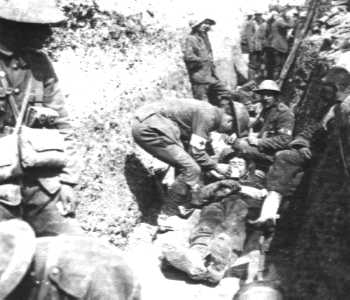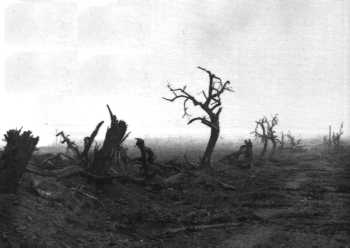Norman Cantor, who confesses his dislike of The Lord of
the Rings, argues in his book The Making of the Middle
Ages that Tolkien's contribution to our understanding of
the Middle Ages is in the way that he brings to our attention
to horrors of medieval warfare. He could not be more wrong.
Whatever Tolkien's portrayal of warfare may be, it is not a
realistic portrayal of war as it occurred in medieval Europe.
But Cantor was correct in discerning that Tolkien is an important
writer about war.
When The Lord of the Rings became popular in the early
1960s, the baby boom generation naturally connected it with
their parents' experiences in World War II and with the Cold
War (starring the Ring as the Atom Bomb). Such equations annoyed
Tolkien deeply, as he pointed out in his preface to the second
edition. Tolkien had written The Lord of the Rings during
the war and no doubt perceived the 'applicability' (to use his
term). It has also been said that the horrors of Mordor and
the Scouring of the Shire are reflexions of Nazi Germany or
the Communist Soviet Union. However, it is much more likely
that they reflect the real presence of both fascism and communism
in British (and American) politics before the Second World War.
In this Tolkien may be grouped with George Orwell (author of
Nineteen Eighty-Four and Animal Farm) who responded
to what appeared to be a realistic possibility of the development
of totalitarianism in Britain.
Tolkien's formative experience was in the First World War,
when he himself had fought in the trenches. No short summary
can give a sense of the horrors of one of the bloodiest wars
in history. For good accounts of the war, try the Trenches
web site or the BBC
History page. The chapter entitled 'War' in Humphrey Carpenter's
biography of Tolkien is also good. The First World War had a
profound impact on the poetry of the first decades of the twentieth
century. It is useful to compare Tolkien's work to the poems
of writers like Siegfried Sassoon, Wilfred Owen, and Rupert
Brooke. For more information, see Oxford University's excellent
Virtual
Seminar on World War I Poetry.
 |
Tolkien's own experience of the war was profound in a number
of ways. He served as a signal officer for the Lancashire Fusiliers
and arrived at the front in France in June of 1916. As an officer,
Tolkien would have been assigned a batman, servant to take care
of his kit. Soldiers had to endure long periods in close contact
under dreadful traditions in the trenches, and the comraderie
of the trench later influenced Tolkien's writing. As he put
it, 'My "Sam Gamgee" is indeed a reflexion of the
English soldier, of the privates and batmen I knew in the 1914
war, and recognised as so far superior to myself'. The Battle
of the Somme began on 1July, when British soldiers climbed out
of the trenches and advanced towards the enemy line. They had
been told that the German defences were destroyed by Allied
bombing, but they were not, and German machine guns mowed them
down. Tolkien was not there for the initial barrage; his company
did not go into action until 14 July, and that was well for
him, since twenty thousand Allied troops were killed on the
very first day of the battle. When Tolkien arrived, the trenches
and surrounding area were littered with mutilated and decaying
corpses. The stench was intolerable. We may recognise these
sights in the nightmarish vision of the Dead Marshes in The
Lord of the Rings.
 |
The devastation to the landscape made an equal impact. Grass
and corn were destroyed, and the earth became a sea of mud.
What trees remained were stripped of their leaves and branches.
Here too Tolkien may have seen a vision of Mordor. Tolkien saw
battle on several occasions but had managed to remain unhurt
until the end of October, when he contracted 'trench fever',
a disease carried by lice. He was sent to hospital, and, when
the fever did not abate, eventually sent back to Birmingham
to convalesce. After he had recovered, he managed to secure
a posting in Oxford in order to complete his education. But
Tolkien did not escape entirely unscathed. His best friends
from his school days, Rob Gilson and G.B. Smith both perished
in the war. Their loss was a terrible blow to him, as they were
his intellectual comrades in arms. Humphrey Carpenter poignantly
titles his chapter on this episode of Tolkien's life 'The Breaking
of the Fellowship'.
A second point may derived from Cantor's recognition of Tolkien
as a war-writer. War was also a topic frequently described by
medieval authors, or, more specifically, battle, and the performance
of the hero in battle. Anglo-Saxon and early Scandinavian literature
embraced a heroic ethic, one which continued in modified form
as chivalry in the later Middle Ages. The heroic values of courage
and sacrifice are treated extensively in medieval literature,
and these values had never seemed more relevant than in the
First World War. But that was a modern war, in which men were
mown down by the thousands by machine gun fire or asphyxiated
by poison gas, rather than dying gloriously in battle. Tolkien's
contribution to our understanding of the Middle Ages may well
be in the way he draws attention to the value of medieval notions
of heroism in today's society.
[Return to Top | Return
to Topics Page]



